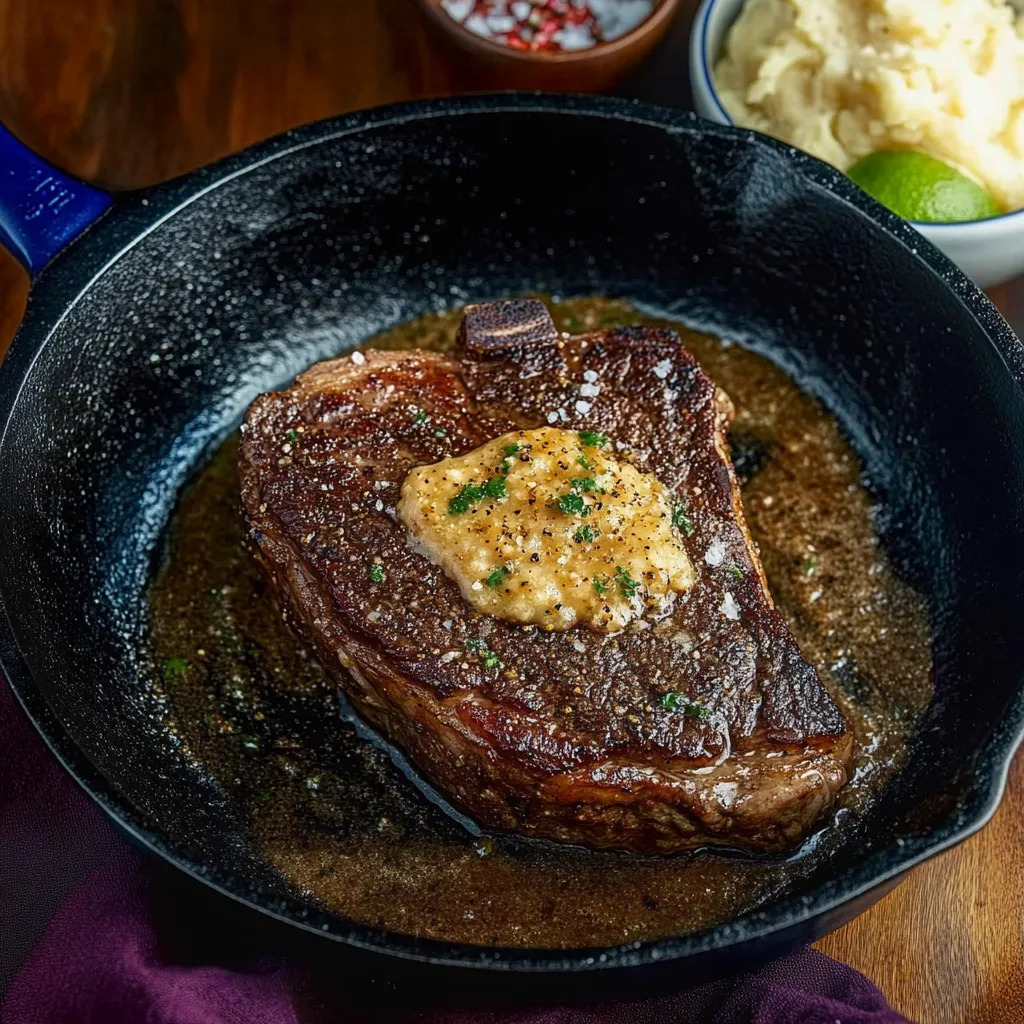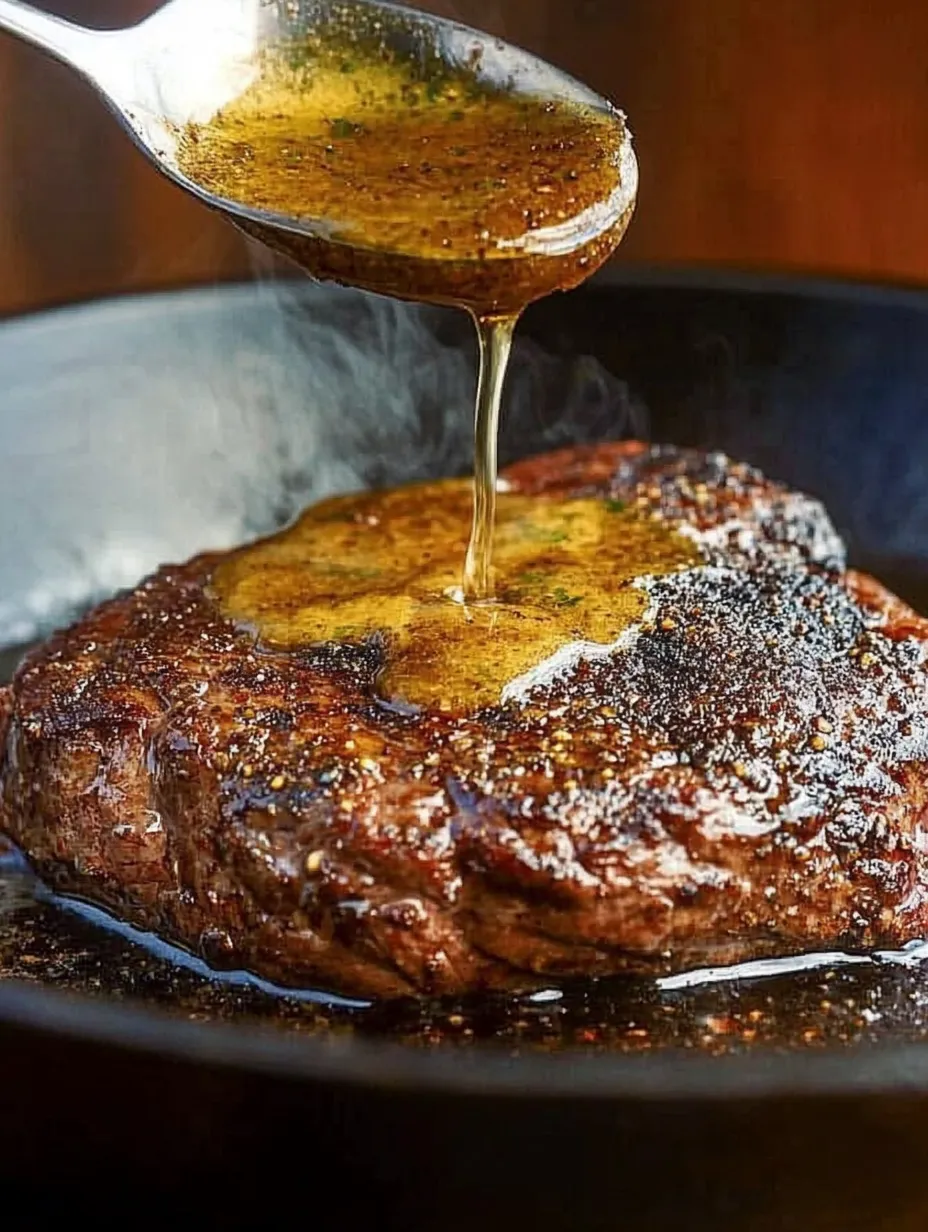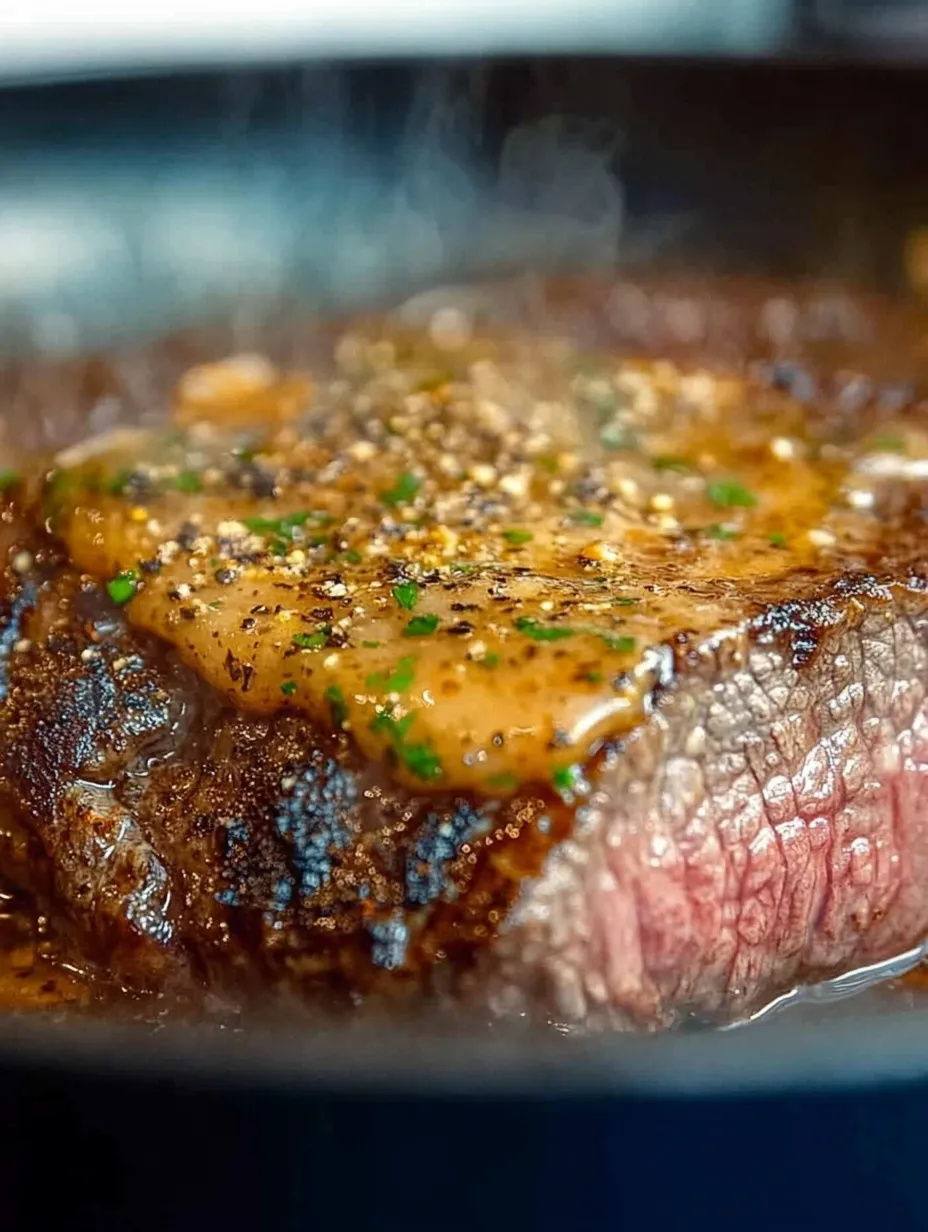 Pin it
Pin it
Sizzling Cajun Steak
This extraordinary blackened steak delivers a perfect balance of bold Cajun spices and luxurious butter in every bite. The magic happens when a well-marbled ribeye or New York strip meets a hot cast iron skillet, creating that signature crust while maintaining a juicy, tender interior. I discovered this technique years ago when attempting to recreate a memorable steakhouse experience at home, and it's become my go-to method for transforming an ordinary steak night into something truly special.
Irresistible Qualities
I first created this recipe when hosting an anniversary dinner at home rather than going out. My husband declared it better than any steakhouse steak he'd ever had, and it's now requested for every special occasion. Even my teenage son, who typically drowns everything in ketchup, enjoys this steak without any additional condiments.
Premium Components
- Ribeye or New York Strip Steak (1½ inches thick): The ideal canvas for this preparation, with ribeye offering superior marbling that melts during cooking to create incredible juiciness, while New York strip provides excellent flavor with slightly less fat
- Homemade Cajun Seasoning: Creates the foundation of flavor with paprika, garlic powder, onion powder, oregano, thyme, and cayenne that penetrates the meat during the high heat cooking process
- Paprika: Adds beautiful color and subtle smokiness that enhances the overall flavor profile without overwhelming the natural beef taste
- Kosher Salt: Essential for proper seasoning that brings out the steak's natural flavors and helps create the perfect crust during searing
- Black Pepper: Provides pleasant heat and complexity that complements the Cajun spices beautifully
- Olive Oil: Creates the essential cooking surface that prevents sticking while promoting even browning and crust development
- Cajun Cowboy Butter: The crowning glory that elevates this dish to extraordinary levels, infusing herb and spice flavor into every bite as it melts into the hot steak
Masterful Method
- Temperature Preparation:
- Begin by removing your steak from the refrigerator a full 30 to 45 minutes before cooking. This critical step allows the meat to come to room temperature, ensuring even cooking from edge to center. Cold steak placed in a hot pan often results in overdone exterior and undercooked interior. While waiting, gather and measure all remaining ingredients so they're ready when needed. Just before cooking, pat the steak thoroughly dry with paper towels on all sides and edges. Removing surface moisture is essential for proper searing and crust development, as moisture creates steam that prevents browning.
- Seasoning Application:
- In a small bowl, combine your Cajun seasoning with additional paprika, kosher salt, and freshly ground black pepper, stirring to create a uniform mixture. The paprika enhances the color of the final crust while adding subtle smokiness. Sprinkle the seasoning mixture generously over both sides of the steak, using your fingers to press it gently into the meat. Ensure complete and even coverage, including the edges for full flavor development. Allow the seasoned steak to rest for about 10 minutes, giving the spices time to adhere properly to the meat surface before cooking.
- Perfect Searing:
- Place a well seasoned cast iron skillet over medium high heat and allow it to become thoroughly hot, about 3 to 4 minutes. The pan should be hot enough that a drop of water instantly evaporates with a sizzle when it hits the surface. Add olive oil to the heated skillet, swirling to create a thin, even coating across the entire cooking surface. Using long handled tongs, carefully place the seasoned steak in the center of the hot skillet, laying it away from you to prevent oil splatter. Resist the urge to move or adjust the steak for a full 3 minutes, allowing an intense crust to develop. The high heat creates a flavorful Maillard reaction while sealing in juices.
- Butter Basting Excellence:
- After the initial sear, flip the steak using tongs to cook the second side. Immediately add two tablespoons of Cajun Cowboy Butter to the side of the pan, not directly on top of the steak. As the butter melts and begins to foam, slightly tilt the pan to pool the butter, then use a large spoon to repeatedly scoop and pour the melted, flavored butter over the top of the cooking steak. This basting technique adds tremendous flavor while promoting even cooking and creating an even more luxurious crust. Continue cooking and basting for about 2 to 3 minutes depending on steak thickness and desired doneness.
- Finishing Touches:
- Using an instant read thermometer inserted into the thickest part of the steak, check for your preferred doneness. For medium rare, look for 130 to 135°F, knowing the temperature will increase a few degrees during resting. Transfer the perfectly cooked steak to a cutting board and immediately top with an additional tablespoon of the Cajun Cowboy Butter. Allow the steak to rest undisturbed for a full 5 minutes, giving the muscle fibers time to relax and reabsorb juices for maximum tenderness. The butter will slowly melt, creating a flavorful sauce that further enhances each bite. After resting, slice the steak against the grain into half inch pieces for serving, drizzling any board juices and melted butter over the slices.
 Pin it
Pin it
I particularly love the versatility of this preparation method. The compound butter makes all the difference in elevating an ordinary steak to something truly memorable. My grandmother taught me that good cooking isn't about complicated techniques but rather understanding how flavors work together. When I make this dish for company, I often prepare extra Cajun Cowboy Butter to serve alongside roasted vegetables or crusty bread. The butter keeps beautifully in the refrigerator, and having it on hand makes even spontaneous meals feel special.
Ideal Accompaniments
This boldly flavored steak pairs beautifully with sides that complement without competing with its robust profile. Consider serving alongside hasselback potatoes roasted with garlic and herbs that become crispy outside and creamy inside. For a lighter option, try a simple arugula salad dressed with lemon juice and olive oil, allowing its peppery notes to cut through the richness of the steak and butter. Grilled asparagus makes an excellent vegetable accompaniment, especially when finished with a light drizzle of balsamic glaze. For a complete steakhouse experience, add sautéed mushrooms with thyme and a splash of cognac. When entertaining, I often include a board of crusty bread for soaking up any remaining Cajun butter, ensuring no flavor goes to waste.
Creative Adaptations
This foundation recipe welcomes numerous variations depending on your preferences and available ingredients. For a Mediterranean twist, adjust the compound butter to include sun dried tomatoes, basil, and feta cheese crumbles. Those seeking less heat might reduce the cayenne in the Cajun seasoning while increasing herbs like thyme and oregano. Seafood lovers can apply this same technique to thick cuts of swordfish or tuna steaks, adjusting cooking time accordingly. The Cajun Cowboy Butter works beautifully on other proteins including chicken breasts, pork chops, or even hearty vegetable steaks like cauliflower or portobello mushrooms. For special occasions, consider topping the finished steak with sautéed garlic shrimp for an elevated surf and turf presentation.
Proper Preservation
If you happen to have leftover steak, proper storage ensures it remains enjoyable for another meal. Allow the steak to cool completely to room temperature before wrapping tightly in aluminum foil or plastic wrap. Place wrapped steak in an airtight container and refrigerate promptly. Properly stored, it will maintain good quality for up to four days. For best results when reheating, bring the steak to room temperature first, then warm gently in a 275°F oven until just heated through, about 15 minutes. Avoid microwave reheating which can toughen the meat. Consider slicing cold leftover steak thinly for luxurious sandwiches or salad toppings rather than fully reheating. The compound butter can be made well in advance and refrigerated for up to one week or frozen for up to three months, making meal preparation even more convenient.
 Pin it
Pin it
After years of perfecting this technique, I've come to appreciate the beautiful simplicity of a properly cooked steak enhanced with thoughtfully balanced flavors. While restaurant steaks often rely on excessive butter and salt for flavor, this method creates depth through the careful application of spices and controlled cooking. The marriage of high heat searing with the richness of compound butter creates a dining experience that feels indulgent yet isn't overly complicated. Even on busy weeknights, taking just a few extra minutes to prepare this dish properly transforms an ordinary meal into something truly memorable that brings everyone eagerly to the table.
Frequently Asked Questions
- → What is Cajun Cowboy Butter and how do I make it?
- Cajun Cowboy Butter is a compound butter flavored with Cajun seasonings, herbs, and aromatics. To make it, combine 1 stick of softened butter with 1 tablespoon of Cajun seasoning, 1 clove of minced garlic, 1 tablespoon of chopped parsley, 1 teaspoon of lemon juice, and a pinch of red pepper flakes. Mix well, form into a log using plastic wrap, and refrigerate until firm.
- → Why do I need to let the steak rest at room temperature before cooking?
- Allowing the steak to come to room temperature for 30-45 minutes before cooking ensures more even cooking throughout. A cold steak placed on a hot pan will cook unevenly, with the outside potentially overcooking before the center reaches the desired temperature. This resting time creates a better, more consistent result.
- → What internal temperature should I aim for when cooking steak?
- For medium-rare, aim for 130-135°F. For medium, 135-145°F. For medium-well, 145-155°F. Remember that the steak will continue cooking during the rest period, rising approximately 5 degrees, so remove it from heat when it's about 5 degrees below your target temperature.
- → Can I use a different cut of steak for this recipe?
- Yes, while ribeye and New York strip are recommended for their marbling and flavor, you can also use other cuts like sirloin, filet mignon, or t-bone. Just adjust cooking times based on thickness - thinner cuts will cook faster, while thicker cuts will need more time to reach your desired doneness.
- → What's the best way to get a good sear on the steak?
- For the best sear: 1) Pat the steak completely dry before seasoning, 2) Use a cast iron skillet or heavy-bottomed pan that retains heat well, 3) Heat the pan until it's very hot before adding oil, 4) Don't overcrowd the pan - cook one steak at a time if needed, and 5) Resist the urge to move the steak - let it develop a crust before flipping.
- → What can I serve with Blackened Steak with Cajun Cowboy Butter?
- This flavorful steak pairs wonderfully with roasted or mashed potatoes, creamy polenta, or dirty rice for a Southern theme. For vegetables, consider grilled asparagus, sautéed green beans, or a simple side salad. A glass of bold red wine like Cabernet Sauvignon or Zinfandel complements the rich flavors nicely.
